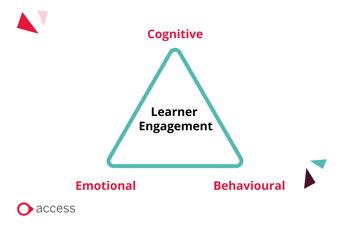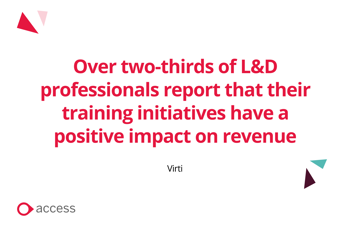What is engagement in learning? Understanding what good looks like in your L&D programmes
What fuels truly effective learning in the workplace? The answer is engagement - and the impact is significant: workers are over three times more likely to describe themselves as highly productive when they have undertaken training.
This article delves into the core definition of learning engagement, exploring its significance in the world of Learning and Development.
What is engagement in learning?
Engagement in learning refers to how invested and involved learners are with the L&D programmes provided. When employees are motivated to learn, they are more likely to absorb the information delivered to them. For mandatory eLearning training such as GDPR and Health and Safety, engagement in learning is essential for both a productive and compliant workforce.
Engaged learning definition
Engaged learning is defined by learners who are actively involved with and motivated to carry out learning. An engaged learner is not simply a recipient of information but an active and eager participant in absorbing the learning materials. Real engagement is the desire to learn and apply the knowledge.
How does learning engagement differ from participation?
Participation in learning involves taking part, while engagement requires a deeper involvement in it, and usually means learners have a connection with the materials provided. By being engaged in the learning, they will make the effort to understand concepts deeply, which is crucial for key topics that help employees carry out their job roles effectively. If a learner is merely participating in learning, they may not be taking in the information needed.
Engaging with assigned learning
In a workplace setting, engaging with learning usually refers to an employee completing courses, carrying out relevant reading or attending sessions, but true engagement goes one step further - it means they actively seek out learning opportunities that will help them develop knowledge in key areas. Being able to prove engagement through data is an essential part of engagement with assigned learning in the workplace, as measures of engagement will provide insights into the effectiveness of learning initiatives.

Types of learning engagement
There are different types of learning engagement which must be discussed when looking at what engagement in learning is. Let’s explore them in detail:
Cognitive engagement
Cognitive engagement refers to a learner who is mentally invested in their learning initiatives, meaning they are interested and curious about the learning opportunities provided. An example in the workplace would be an employee applying critical thinking learned during a training module to solve problems.
To encourage cognitive engagement with learning, consider utilising an AI-enabled Learning Management System which recommends content tailored to an employee’s specific role. This will make the training you deliver feel individual and relevant to each user.
Emotional Engagement
An emotionally engaged learner is someone who feels connected to the learning materials. They feel a sense of purpose when completing learning. An example of this in the workplace is a learner demonstrating understanding and meaning around a topic that may usually be difficult to understand.
To nurture emotional engagement in learning, you should frame learning content within compelling stories, using real life examples where suitable to make learning stick.
Behavioural Engagement
Behavioural engagement focuses on how a person acts and responds to learning materials, showing their visible commitment to it. An example of this in the workplace would be a learner maintaining focus and reducing distractions during learning sessions.
Enhancing behavioural engagement could involve encouraging managers to celebrate learning success, recognising and rewarding employees with badges and certificates through an LMS, or even using employee recognition programs to offer tangible rewards.
Social Engagement
While not usually discussed as one of the three main types of learning engagement, there is a place for social engagement. It is the process of using social interactions and collaboration to make learning more exciting. An example of this is a learner actively sharing what learning they have undertaken and making recommendations in their work networks.
Gamification is a great way to instill social engagement, as it uses interactive gameplay and friendly competition, meaning learners are more likely to remember key information as well as enjoy their training.

Why is learning engagement crucial for L&D success?
L&D teams provide the tools and resources to deliver targeted training across an organisation. However, to warrant further investment in these initiatives, they must demonstrate that the learning they offer is adding value to the organisation. One of these demonstratable measures is a high level of learning engagement.
When learners are actively involved and invested in the learning process, the training is far more likely to translate into tangible results. This engagement is what turns training from a "check-the-box" exercise into actionable changes to behaviour and the successful building of skills.
By prioritising engagement, L&D professionals can ensure their efforts translate into measurable outcomes, making learning a truly valuable and impactful investment for both individuals and the organisation.
The broader need for learning engagement
The importance of learning engagement extends far beyond the L&D department. While L&D teams are central to creating engaging learning experiences, the strategic value of learning and development involves the entire organisation. In fact, 42% of organisations have increased learning and development opportunities as a key strategy to boost employee retention, which highlights its broader impact.
However, the effectiveness of these opportunities is linked to how engaged employees are in the learning process. The 2025 LinkedIn Learning report found that only 30% of managers encouraged their employees to spend time learning (a notable 6% decrease from last year), underscoring a challenge that needs to be addressed. Without the support of the entire organisation, learning engagement just won’t be achieved.

Understanding ‘good’ learning engagement
To successfully engage employees in learning, you must first understand what good means to your organisation. This involves mapping out the KPI’s of learning engagement and assessing how they are met.
Key indicators for engagement in learning could include:
- Learner participation
- Completion rates
- Enjoyment of learning
- Application of skills learned
- Consistent achievement on tests and quizzes
Assessing engagement in your L&D programmes
Effectively assessing engagement within your Learning and Development (L&D) programmes requires a multi-faceted approach. This involves gathering both quantitative and qualitative data.
Quantitative data could be:
- Participation metrics
- Time to completion
- Certification/accreditation rates
Utilising an LMS with built-in tracking features will provide a rich source of quantitative data to demonstrate the effectiveness of your L&D programmes. It will also help you monitor user engagement within your LMS, metrics which will directly influence learning engagement across your organisation.
Qualitative data may include:
- Perceived value of the content delivered
- Observations of changes in employee behavior or performance
- Conversations with learners about their experience
These kinds of metrics require digging into less quantifiable insights that instead offer context and understanding, which is essential for continuous improvement of your learning programmes. Using a blend of both quantitative and qualitative data will show stakeholders the demonstrable impact of learning on individual and organisational performance.

Practical implications for L&D professionals
Understanding the nuances of learning engagement carries significant practical implications for L&D professionals. Moving beyond simply delivering content, the focus must shift towards designing engaging learning experiences that are relevant and meaningful. It also requires L&D teams to be the driving force behind creating a transformational performance-based culture, as learning engagement encourages the mindset, skills, and behaviors needed for this to be achieved.
On a broader scale across your organisation, good learning engagement can influence:
- Employee retention: Those who are actively engaged in their learning and development feel more valued, invested in, and connected to the organisation. When employees perceive opportunities for growth and advancement, they are more likely to remain with the company long-term, reducing costly turnover and preserving valuable institutional knowledge.
- Budget decisions: Demonstrating a clear return on investment (ROI) for L&D initiatives becomes significantly easier when learning engagement is high. Encouragingly, over two-thirds of L&D professionals report that their training initiatives have a positive impact on revenue, demonstrating that learning and development is a significant driver of business success.
- Talent attraction: An organisation with a strong reputation for learning and development becomes a magnet for top talent. Prospective employees are increasingly seeking out employers who focus on providing impactful learning opportunities, so explicitly showcasing the effectiveness of learning engagement within your organisation
Final thoughts on learning engagement
The success of L&D teams hinges on high levels of engagement. By knowing the different types of learning engagement, what good looks like for your organisation and showcasing the influence learning engagement has, you will be able to demonstrate to stakeholders the value of your L&D programmes.
Boost engagement with our learning solutions
Our suite of Digital Learning Solutions includes eLearning content specifically designed to capture and maintain the attention of learners.
Onboarding
Simplify onboarding through our powerful LMS. Empower users to assign essential training, track progress, and access robust reporting tools.
Soft Skills & Compliance Training
Supercharge compliance training through our large online learning catalogue. Accredited and written alongside subject matter experts you'll always be getting up-to-date eLearning content.
Upskilling
Transform upskilling and professional development with dynamic content in audio, eBook, and virtual classroom formats - highly engaging and effortlessly accessible.

 AU & NZ
AU & NZ
 SG
SG
 MY
MY
 US
US
 IE
IE

